My Legs Are Going to Paradise
©Thomas Wilson Shawcross, 19 Jun 2004

Todaiji Temple in Nara, Kansai, Japan
Photo credit Tom Shawcross
On 26 July 1992, I made sure that my legs would go to Paradise. I would have preferred to send the entire package, of course, but I could get only my legs to pass through the “Nose Hole of Nara.”
The Nose Hole of Nara
Frankly, I considered giving this story the title “Nose Hole of Nara,” but that sounded a bit too much like a title for a Harrison Ford movie (this could have been one of his “Indiana Jones” adventures, perhaps). In reality, a beautiful Japanese flight attendant provided this term to me, and I suspect that her command of the English language did not include the word “nostril.”
The adventure I am about to describe began as I sat on board an airplane, awaiting takeoff to Tokyo. I had been watching a pre-flight slide show of Japanese tourist attractions, when suddenly I was surprised to see a huge statue of the Buddha. I didn’t think that Buddhism was popular in Japan, and I wondered if one of the China slides had gotten into the slide tray by mistake. I asked a flight attendant about it.
She said it was indeed a Japanese statue; that it was the largest bronze Buddha in the nation, and that it was located in the ancient Japanese city of Nara. Then she said something that was even more surprising. “All Japanese people have gone through the Nose Hole of Nara.”
She explained that the giant statue was inside an even more giant wooden temple, and that the interior of the temple contained several enormous wooden support columns, formed from tree trunks. At the base of one of these columns was a hole. The hole was the size of a “nose hole” (the statue’s), and the tradition was that if one could pass through the nose hole of Buddha, one would enter Paradise in the after-life. She said the temple was a popular field trip destination for Japanese school children, and that nearly every Japanese student had crawled through the nose hole at some time in his or her life.
I knew then that I had to do it too.
The only problem was that I was going to be in Tokyo (on business) and Nara wasn’t exactly a suburb of Tokyo. To get to Nara, I had to take the bullet train to Kyoto and then a local railway to Nara (anything worth doing is hard).
As I approached the Todaiji Temple, I was surprised to see it surrounded by a park and hundreds of tiny deer. Not exactly wild deer, they were accustomed to panhandling visitors for tasty “deer cookies” (sold at multiple stands within the park).
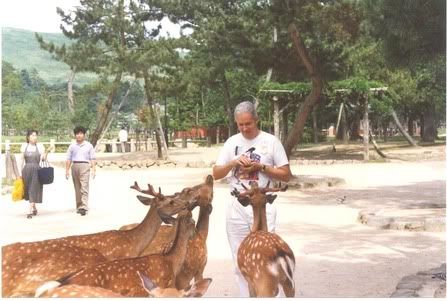
Above: Tom Shawcross feeding “deer cookies” to the local “sacred messengers.”
Head-liner celebrities that perform stage acts and concerts always seem to have opening acts that precede them, so it was not surprising to learn that several lesser statues preceded the viewing of the giant Buddha statue known as the Diahutsu. I photographed one of the statues at the entrance, and also one of the Buddha statues housed inside the mammoth temple (said to be the largest wooden building in the world).
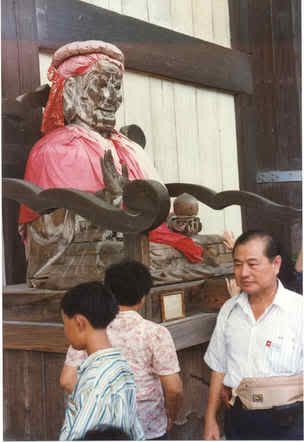
Portal Guardian Statue
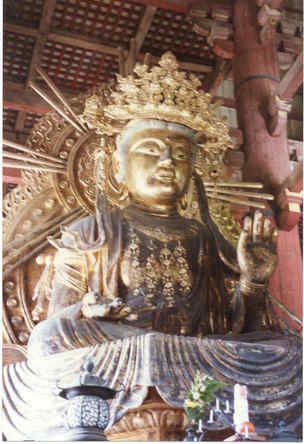
99%
I nicknamed this statue “99% Buddha” because a nearby sign explained that in this statue, Buddha was only 99% enlightened, because he was wearing jewelry. Who knew that wearing serious “bling” was a sign of diminished enlightenment? (Actually, I had suspected this!)
Nearby sat the 53-feet tall, 452-ton statue of Buddha that I had seen in the airplane. Known as the Diahutsu, it is much larger-looking than it appears to be in this photo. The Buddha is sitting with his legs crossed in the Lotus Position. I supposed if standing erect, his head would have hit the ceiling. I learned that this was the third version of the statue, and it was only 2/3 the size of the original two, which had melted when the previous temples had been destroyed by fires.
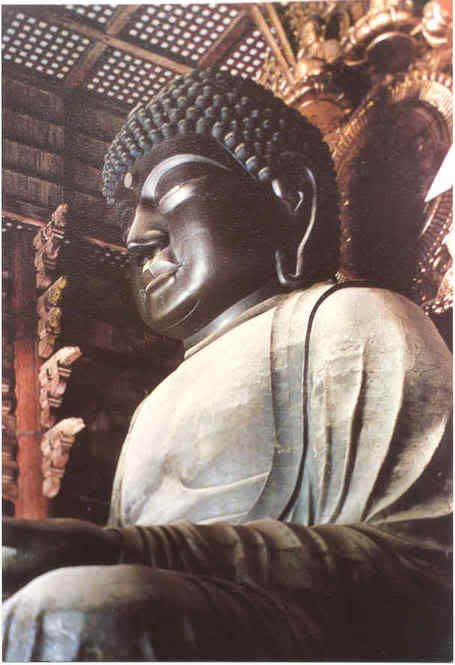
The Diahutsu, Photo credit: Tom Shawcross
Having viewed and photographed the Diahutsu, I now proceeded with my main goal, which was to find the nose hole and pass through it. There were several huge wood columns inside the temple, but only one was surrounded by busloads of Japanese school children. Trying to appear nonchalant, I approached their column.
The “Nose Hole” reminded me of the photos I have seen in which an automobile is driven through a California Redwood tree, except that the nose hole is smaller.
I bided my time as excited students streamed on all fours through the nose hole. They shot through it like lemmings hurling themselves off cliffs. I wasn’t sure if adults were allowed to go through the nose hole, even if they were native citizens, so I decided to wait until no one was looking . . .
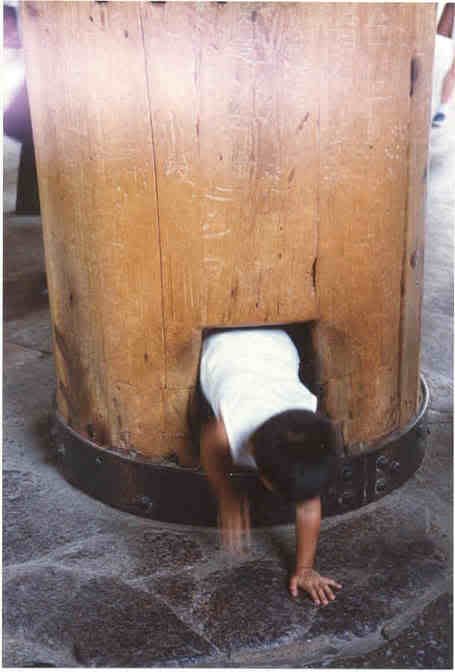
Passing Through the Nose Hole
photo credit: Tom Shawcross
I had to wait a long time. Busload after busload of children arrived and darted through the hole. Finally, my patience was rewarded. I knew I was too large to make it through while crawling on all fours, as the children had done. I decided to lie on my back, insert my legs into the hole, and then effortlessly slide through.
My legs got through just fine, but when I got to my shoulders, I found that I was getting wedged. Should I try to bull my way through? What if I got stuck? That would not only be embarrassing, it might lead to my next tourist destination being the inside of a Japanese prison. With great disappointment, I abandoned my quest (but next time I returned I vowed I would bring a jar of Vaseline jelly and a pair of Speedos). But, if I never return, at least my legs will be going to Paradise.

Todaiji Temple in Nara, Kansai, Japan
Photo credit Tom Shawcross
On 26 July 1992, I made sure that my legs would go to Paradise. I would have preferred to send the entire package, of course, but I could get only my legs to pass through the “Nose Hole of Nara.”
The Nose Hole of Nara
Frankly, I considered giving this story the title “Nose Hole of Nara,” but that sounded a bit too much like a title for a Harrison Ford movie (this could have been one of his “Indiana Jones” adventures, perhaps). In reality, a beautiful Japanese flight attendant provided this term to me, and I suspect that her command of the English language did not include the word “nostril.”
The adventure I am about to describe began as I sat on board an airplane, awaiting takeoff to Tokyo. I had been watching a pre-flight slide show of Japanese tourist attractions, when suddenly I was surprised to see a huge statue of the Buddha. I didn’t think that Buddhism was popular in Japan, and I wondered if one of the China slides had gotten into the slide tray by mistake. I asked a flight attendant about it.
She said it was indeed a Japanese statue; that it was the largest bronze Buddha in the nation, and that it was located in the ancient Japanese city of Nara. Then she said something that was even more surprising. “All Japanese people have gone through the Nose Hole of Nara.”
She explained that the giant statue was inside an even more giant wooden temple, and that the interior of the temple contained several enormous wooden support columns, formed from tree trunks. At the base of one of these columns was a hole. The hole was the size of a “nose hole” (the statue’s), and the tradition was that if one could pass through the nose hole of Buddha, one would enter Paradise in the after-life. She said the temple was a popular field trip destination for Japanese school children, and that nearly every Japanese student had crawled through the nose hole at some time in his or her life.
I knew then that I had to do it too.
The only problem was that I was going to be in Tokyo (on business) and Nara wasn’t exactly a suburb of Tokyo. To get to Nara, I had to take the bullet train to Kyoto and then a local railway to Nara (anything worth doing is hard).
As I approached the Todaiji Temple, I was surprised to see it surrounded by a park and hundreds of tiny deer. Not exactly wild deer, they were accustomed to panhandling visitors for tasty “deer cookies” (sold at multiple stands within the park).

Above: Tom Shawcross feeding “deer cookies” to the local “sacred messengers.”
Head-liner celebrities that perform stage acts and concerts always seem to have opening acts that precede them, so it was not surprising to learn that several lesser statues preceded the viewing of the giant Buddha statue known as the Diahutsu. I photographed one of the statues at the entrance, and also one of the Buddha statues housed inside the mammoth temple (said to be the largest wooden building in the world).

Portal Guardian Statue

99%
I nicknamed this statue “99% Buddha” because a nearby sign explained that in this statue, Buddha was only 99% enlightened, because he was wearing jewelry. Who knew that wearing serious “bling” was a sign of diminished enlightenment? (Actually, I had suspected this!)
Nearby sat the 53-feet tall, 452-ton statue of Buddha that I had seen in the airplane. Known as the Diahutsu, it is much larger-looking than it appears to be in this photo. The Buddha is sitting with his legs crossed in the Lotus Position. I supposed if standing erect, his head would have hit the ceiling. I learned that this was the third version of the statue, and it was only 2/3 the size of the original two, which had melted when the previous temples had been destroyed by fires.

The Diahutsu, Photo credit: Tom Shawcross
Having viewed and photographed the Diahutsu, I now proceeded with my main goal, which was to find the nose hole and pass through it. There were several huge wood columns inside the temple, but only one was surrounded by busloads of Japanese school children. Trying to appear nonchalant, I approached their column.
The “Nose Hole” reminded me of the photos I have seen in which an automobile is driven through a California Redwood tree, except that the nose hole is smaller.
I bided my time as excited students streamed on all fours through the nose hole. They shot through it like lemmings hurling themselves off cliffs. I wasn’t sure if adults were allowed to go through the nose hole, even if they were native citizens, so I decided to wait until no one was looking . . .

Passing Through the Nose Hole
photo credit: Tom Shawcross
I had to wait a long time. Busload after busload of children arrived and darted through the hole. Finally, my patience was rewarded. I knew I was too large to make it through while crawling on all fours, as the children had done. I decided to lie on my back, insert my legs into the hole, and then effortlessly slide through.
My legs got through just fine, but when I got to my shoulders, I found that I was getting wedged. Should I try to bull my way through? What if I got stuck? That would not only be embarrassing, it might lead to my next tourist destination being the inside of a Japanese prison. With great disappointment, I abandoned my quest (but next time I returned I vowed I would bring a jar of Vaseline jelly and a pair of Speedos). But, if I never return, at least my legs will be going to Paradise.


0 Comments:
Post a Comment
<< Home